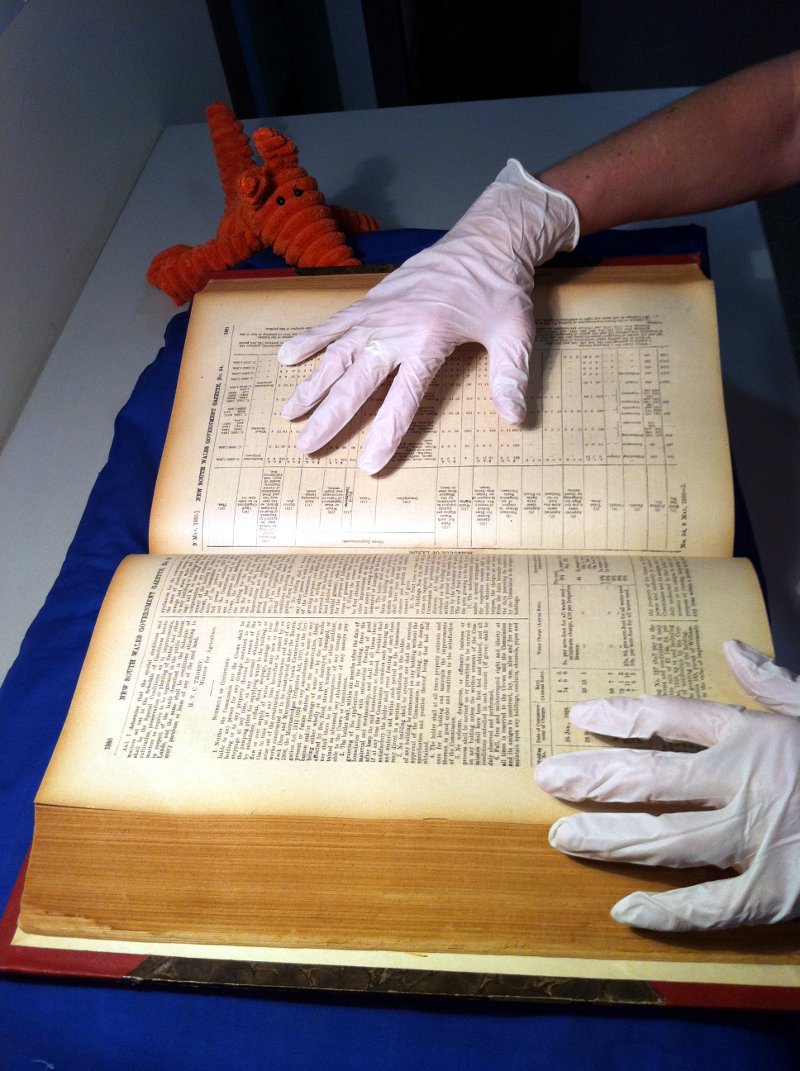These tips are from our in-house manual handling procedures and guidelines that were prepared by our Senior Conservator, Elizabeth Hadlow.
General Handling Procedures
All handling causes damage – so handle Archives as little as possible
Key points to remember
- Wear gloves when you can – plastic are best
- Wash your hands thoroughly with soap and water before and after handling Archives
- Handle documents as little as possible
- Support records appropriately at all times
- Prepare a clean work space on which to use the Archives
- Only use pencil to take notes when examining original Archives
- Treat all Archives as if they are fragile
The above points are explained in more detail below.
1. Wear gloves when you can
- It is usually best to wear gloves when handling Archives
- Always wear gloves when handling photographic materials
- When is it okay not to wear gloves?
- When the document has fragile edges or
- is brittle
- Gloves protect both the Archives and your health – plastic gloves in particular prevent potentially harmful substances being transferred to your hands
- Plastic gloves are better than cotton gloves –
- They stay cleaner for longer
- They don’t transfer dirt from record to record
- They prevent more oil transfer from your hands
- They retain more dexterity and nimbleness in your fingers

2. Wash your hands – before and after
- Oils and acids are produced by your skin all the time. In order to transfer as little of these harmful substances to the Archives it is necessary to wash your hands regularly when handling Archives (at least every hour)
- Archives will have been stored in a range of places. Sometimes they contain dirt, mould and animal droppings that may affect your health. Always wash your hands before eating
- Do not lick or wet your fingers to turn pages
3. Handle documents as little as possible
- Don’t pick up an Archive up if you can examine it on the desk
- Use trolleys and other devices to support the Archive while moving it
- Use weights to hold pages in position – don’t use your hands
- Move yourself to the Archive, rather than the Archive to you. If you need to show someone the Archive, ask them to come to it, rather than taking it to them.
4. Support records appropriately at all times
- Always fully support the Archive –
- Don’t hold by the edges and corners
- Be aware of tears and other fragile areas (e.g. mould, insect, and rust damage)
- Use book pillows to support all books while examining them
- Place a rigid support board on your trolley to transport plans flat – do not carry them by their edges or corners.
- If the plan is too large to move flat – then use a sheet of polyester plastic as a strap support under the plan and carry in an open U shape.
- Use weights to hold records in position
5. Prepare a clean work surface
- Ensure the surface is free of debris of any kind – food, dust, scraps of paper, rust from fasteners, mould, etc.
- Use a brush to clean the surface between each Archive
- Wipe the surface at least once a day with 50/50 Methylated Spirits
- Cover your work surface with a clean sheet of blotter or card and replace it regularly – it is easier to see dirt on clean paper
- Replace and clean book pillow covers regularly

6. Only use pencil when handling original records
- Never use pens when handling original records – marks made by ink cannot be removed
- Accidental pencil marks can be more easily removed than pen
7. Treat all records as fragile
- Examine the Archive carefully beforehandling it – try to observe any areas that need additional support or care
- Bottom right corner is usually the weakest part of the page – avoid using this area
- Do not bend creases back on themselves to flatten the paper – this will usually split the paper
- Paper around fastenings (e.g. pins, staples, red tape) is usually more fragile
- Sometimes Archives can be more fragile than they appear – it’s best to err on the side of caution and handle them as if they are
- Archives are still fragile when they are encapsulated in polyester pockets.
Category: Preservation
Tag: handling archives, tips
